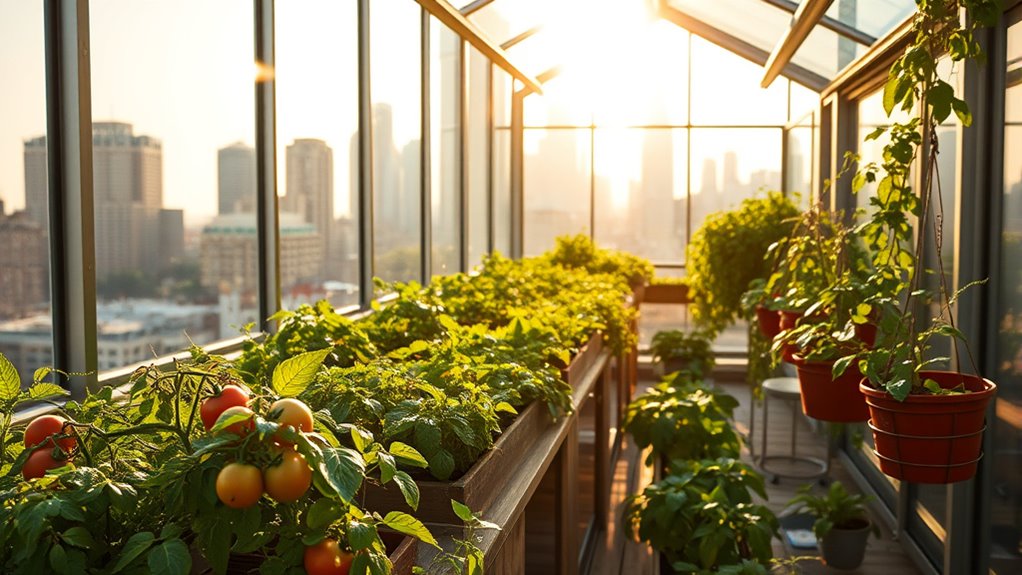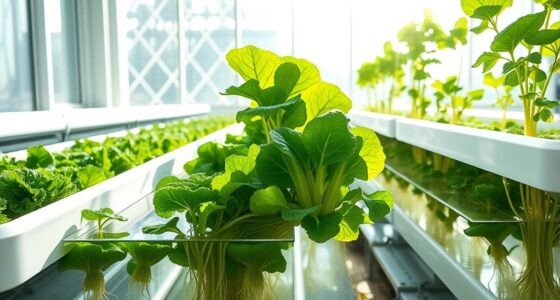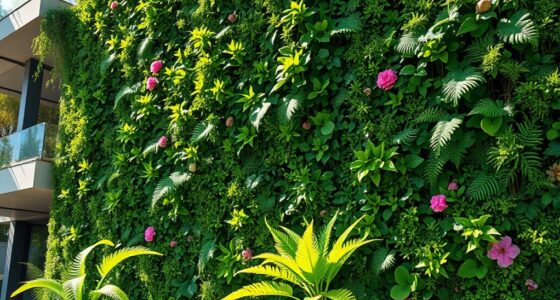Urban greenhouses powered by solar panels and hydroponic systems let you extend your growing season year-round, even in limited city spaces. By using renewable energy to run climate and watering systems, you can grow fresh vegetables, herbs, and fruits beyond traditional outdoor seasons. These innovative setups maximize your space, reduce resource use, and promote sustainability. Keep exploring to discover how these technologies can transform your urban farming efforts and keep your harvests thriving all year long.
Key Takeaways
- Use innovative greenhouse structures to create controlled environments that protect crops from harsh outdoor weather.
- Install solar panels to power climate control and lighting systems, ensuring year-round optimal growing conditions.
- Implement hydroponic systems to maximize space efficiency and support continuous crop production indoors.
- Extend growing seasons by maintaining stable temperatures and lighting through renewable energy solutions.
- Combine solar and hydroponic technologies to promote sustainable, year-round urban farming in limited spaces.

Have you ever wondered how cities can grow fresh produce without expanding their footprint? The answer lies in urban greenhouses, innovative structures that extend your growing season while making the most of limited space. These greenhouses are designed to maximize efficiency, often incorporating cutting-edge technology like solar panels and hydroponic systems. By doing so, they transform vacant rooftops, vacant lots, or unused indoor spaces into productive farms, allowing you to enjoy fresh vegetables, herbs, and fruits year-round.
Solar panels play a crucial role in making urban greenhouses sustainable and energy-efficient. When installed on the greenhouse roof or nearby structures, they harness sunlight to generate electricity, reducing reliance on external power sources. This renewable energy can power climate control systems, lighting, and automated watering, helping you maintain optimal growing conditions regardless of outdoor weather. By integrating solar panels, you lower operating costs and minimize your carbon footprint, making your urban farm both eco-friendly and economically viable.
Solar panels power greenhouses sustainably, reducing costs and environmental impact while maintaining optimal growing conditions year-round.
Hydroponic systems are equally vital in these settings, enabling you to grow plants without soil. Instead of traditional planting methods, nutrients are delivered directly to the roots through a water-based solution. This approach requires less space and water, making it ideal for urban environments where resources are limited. Hydroponics also allows for faster plant growth and higher yields, so you can harvest more frequently and enjoy a diverse array of crops. Plus, because these systems are often enclosed within the greenhouse, pests and diseases are easier to control, reducing the need for chemical interventions.
Together, solar panels and hydroponic systems create a synergy that makes urban greenhouses highly efficient. The solar energy powers the hydroponic setup, ensuring a continuous supply of light and climate control without excessive energy costs. This integration allows you to extend your growing season well beyond traditional outdoor limits, regardless of the weather outside. You can cultivate delicate herbs in winter or produce early crops before outdoor planting seasons begin, all within the comfort of your city environment.
In essence, urban greenhouses equipped with solar panels and hydroponic systems offer a practical solution to city living’s space and resource constraints. They empower you to grow fresh, healthy food throughout the year, reduce your reliance on imported produce, and contribute to a greener, more sustainable urban landscape. With these technologies working in harmony, you’re not just gardening—you’re pioneering a smarter, more resilient way to feed city populations. Incorporating the latest solar technology also enhances system efficiency, making your urban farm more productive and sustainable over time.
Frequently Asked Questions
What Are the Initial Costs of Setting up an Urban Greenhouse?
When you consider setting up an urban greenhouse, the initial costs can vary widely. You’ll need to think about cost considerations like purchasing or building the structure, installing lighting, heating, and ventilation systems. It’s crucial to include financial planning for equipment, permits, and ongoing maintenance. By carefully estimating these expenses upfront, you can better prepare your budget and ensure your project starts smoothly without unexpected financial surprises.
How Much Space Is Needed for a Productive Urban Greenhouse?
Like planting seeds in fertile soil, you need enough space to thrive. For a productive urban greenhouse, aim for at least 100 to 200 square feet, depending on your goals. Incorporate vertical farming and hydroponic systems to maximize limited areas efficiently. These methods let you grow more in less space, making your small urban greenhouse highly productive and sustainable without requiring extensive land.
Can Urban Greenhouses Be Environmentally Sustainable?
Yes, urban greenhouses can be environmentally sustainable. You can achieve this by using renewable energy sources, like solar or wind power, to run your greenhouse systems. Additionally, water conservation techniques, such as rainwater harvesting and drip irrigation, help minimize water waste. By incorporating these practices, you reduce your carbon footprint and promote eco-friendly urban agriculture, making your greenhouse both productive and sustainable.
What Are Common Pests and How to Manage Them Indoors?
Ever wondered how to keep your indoor garden pest-free? You’ll want to focus on pest identification early on to recognize issues quickly. Common pests like aphids, spider mites, and whiteflies can be managed with biological control methods, such as introducing beneficial insects like ladybugs or predatory mites. Regular inspection and maintaining proper humidity and airflow help prevent infestations. Isn’t it rewarding to grow healthy plants free of chemical pesticides?
How Do Urban Greenhouses Affect Local Air Quality?
You might wonder how urban greenhouses impact local air quality. They can help improve air quality by filtering urban pollution through air filtration systems, reducing pollutants like dust and VOCs. However, if not managed properly, they might contribute to urban pollution from energy use or emissions. Overall, well-maintained greenhouses can positively influence air quality by enhancing local greenery and filtering airborne contaminants.
Conclusion
So, why not embrace urban greenhouses and extend your growing season? Imagine tending your plants like a modern-day gardener, but with the charm of a Victorian conservatory. With a little ingenuity, you can enjoy fresh herbs and veggies year-round, even if you’re stuck in a digital age of screens and chaos. Greenhouses turn your city space into a lush oasis, proving that with some vision, you can grow your own paradise—no DeLorean needed!








